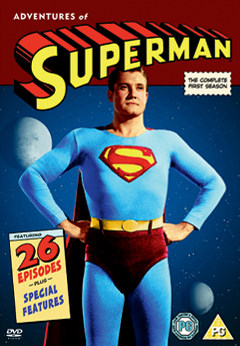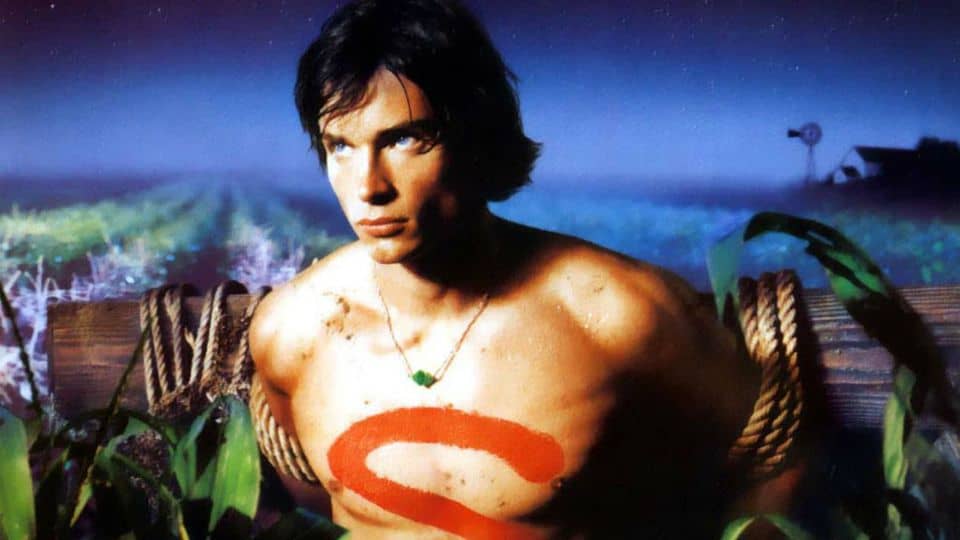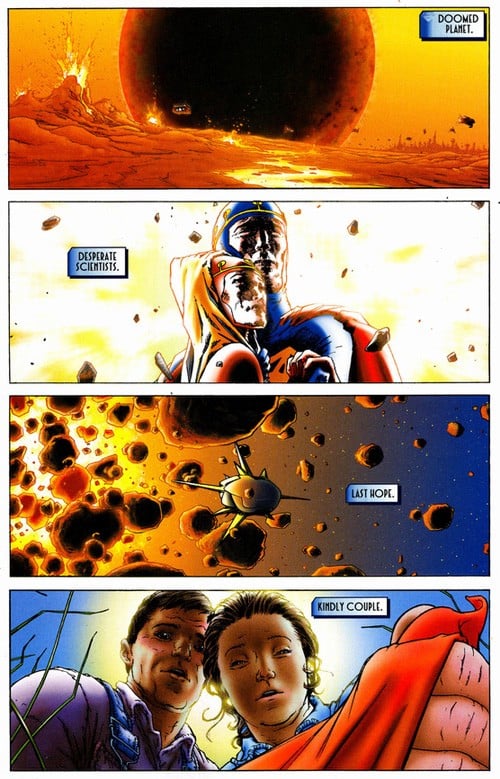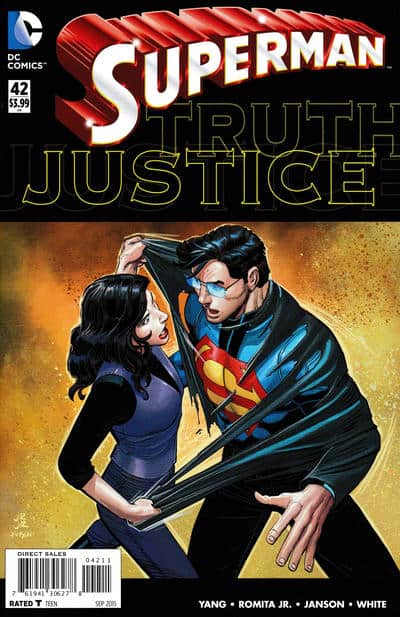Superman
Real Name
Clark Kent/Kal-El
First Appearance
Action Comics #1, June 1938
Nicknames and Aliases
Supes, The Last Son of Krypton, the Big Blue Boy Scout.
Powers and Abilities
“Faster than a speeding bullet! More powerful than a locomotive! Able to leap tall buildings in a single bound!”
Though the extent and level of Superman’s powers have varied through the years, his core abilities remain superhuman strength, speed, senses, durability and the ability to fly. He also usually has some combination of enhanced vision, be it telescopic, X-ray, microscopic or heat. The earliest Golden Age stories depicted a more grounded Superman, one who could only leap great distances rather than fly, while the Superman of the Silver Age was nearly godlike in his abilities, including a wide bevy of powers such as freeze breath, a super kiss that erased memories, super-intelligence, super-ventriloquism, the ability to travel through time and shoot miniature versions of himself from his finger.
Following the Silver Age, concerted efforts were made to reign in his power to make him more down-to-earth (and thus, easier to write for, as he didn’t necessarily overpower every antagonist he encountered), but he is still considered to be one of the most powerful heroes in the DC Universe (at least until his most recent comic book de-powering).
Additionally, Superman is a top-notch investigative journalist.
Weaknesses and Achilles’ Heels
Kryptonite, irradiated chunks of his home planet, perhaps the most famous weakness in comics, severely weakens Superman and prolonged exposure runs the risk of killing him. In addition to the traditional green kryptonite, the Silver Age introduced a wide variety of kryptonites, each triggering a different effect (Green K weakens and kills Superman, Gold K takes away his powers, Red K is a wild card, etc.).

As Superman’s fantastic abilities are derived from the way his alien body metabolizes the radiation from Earth’s yellow sun, prolonged exposure to other forms of radiation (such as from a red sun) or prolonged time away from the sun’s light can weaken or remove his powers.
Superman is also susceptible to magic and magical items, as well as women with the initials “LL”.
Gadgets and Accessories
Generally one to eschew a lot of gadgets, Superman does have a secret base, his Fortress of Solitude, located in the Arctic, and has been known to deploy Superman robots and other bits of salvaged Kryptonian technology from time to time.
Friends and Allies
Lois Lane (his girlfriend/wife/fellow reporter), Jimmy Olsen (his pal), Perry White (his boss at the Daily Planet), Jonathan and Martha Kent (his adoptive parents), Lana Lang (his childhood sweetheart), Pete Ross (his childhood friend), Krypto (his dog), Batman, Wonder Woman, the Justice League of America, the Justice Society of America, the Legion of Superheroes.
Foes and Antagonists
Lex Luthor, Braniac, General Zod, Bizarro, Parasite, Metallo, Mongul, Darkseid, Mr. Mxyzptlk, Prankster, Toyman, Doomsday.
Movies and Appearances
Superman is, not surprisingly, the most prolific comic book character in mediums outside of comics.In the 1940s, he had his own radio show, starring Bud Collyer as Superman, which introduced the character of Jimmy Olsen and kryptonite to the Superman mythology, as well as a live action film serial. The 40s also brought us the iconic cartoon serials by Max Fleischer, which remain one of the most enjoyable and iconic depictions of Superman (it was also the first place to depict him as flying, rather than leaping).
The 1950s brought us the popular Adventures of Superman TV show starring George Reeves, Noel Neill and Jack Larson.

The 1960s featured a variety of Superman cartoons created by Filmation, and Superman was a fixture of the various incarnations of the Super Friends cartoon in the 70s and 80s. 1988 saw the release of a short-lived animated series by Ruby-Spears.
Superman, the character’s first full length feature film, was released in 1978. Starring Christopher Reeve, Margot Kidder and Gene Hackman and directed by Richard Donner, it remains a well-regarded depiction of the character. It led to three more sequels of varied quality, as well as the not-as-well received Superman Returns in 2006, a spiritual sequel to the first two Superman films.
On TV, a live action Superboy TV show in the late 80s (starring first John Haymes Newton and then Christopher Gerad as Superboy) was followed by Lois & Clark: the New Adventures of Superman starring Dean Cain and Teri Hatcher. Smallville, a modern take on the Superboy story starring Tom Welling, Kristen Kreuk and Michael Rosenbaum, began its ten year run in 2001, and it remains the longest running Superman TV show (And by the end there, it was pretty much a full blown live action DC Universe show.).

The late 90s also saw a new Superman cartoon by Bruce Timm and Paul Dini, the creative team responsible for the acclaimed Batman animated series, starring Tim Daly and Dana Delany, and Superman was a fixture of the duo’s later Justice League animated series. Since then, Superman has starred in a wide variety of direct-to-DVD animated films.
And, of course, Henry Cavill nows wears the red cape as the latest cinematic Superman, starring first in Man of Steel and now its follow-up, Batman V. Superman: Dawn of Justice.

One-Sentence Origin
The introduction to the 1950s TV show does a pretty good job with it (albeit in two sentences): “[A] strange visitor from another planet, who came to Earth with powers and abilities far beyond those of mortal men! Superman … who can change the course of mighty rivers, bend steel in his bare hands, and who, disguised as Clark Kent, mild-mannered reporter for a great metropolitan newspaper, fights a never-ending battle for truth, justice, and the American way!”
Or there’s Grant Morrison’s four panel, eight word origin from All-Star Superman #1:

Memorable Moment
Superman Annual #11 (1985) – When Batman, Robin and Wonder Woman arrive at Superman’s Fortress of Solitude to celebrate his birthday, they find alien conqueror Mongul waiting for them, having given Superman a gift which makes him believe he’s living his perfect fantasy life. After Superman awakens from the dream (thanks to an assist from Batman), he attacks the powerful Mongul, enraged not only at his violation of Superman’s sanctuary but for making him live his heart’s desire only to have it ripped away. As their battle rages, Superman uses his heat vision on the villain, telling him simply to burn.

Fun Fact
Superman starred in a Broadway musical in 1966, It’s a Bird…It’s a Plane…It’s Superman!, which was later retooled and broadcast as a TV special in 1975.
Austin’s Analysis
Though Superman hasn’t always been the most popular superhero (These days, Batman, Spider-Man, Wolverine and heck, probably Iron Man and a few other Avengers most likely outpace him in that department.), he was the first superhero, and superhero comics as they exist today wouldn’t without Superman. Even beyond the blatant knockoffs that cropped up in the wake of his immense popularity shortly after his debut (Issues of his comics routinely sold in the millions throughout the 1940s.), Superman can be pointed to as either a direct or indirect inspiration for nearly every superhero that followed. The entire field of superhero comics, the most dominant form of sequential art in American comic books, exists because of Superman.

The notion of a hero with fantastic abilities was certainly around before Superman, as far back (and further) as Greek mythology, and literary elements like the secret identity, devotion to a specific ideal, even the wearing of a cape all predate Superman, but he codified all those elements and wedded them to the visual medium of comic strips. His influence extends even beyond comics books: terms like “kryptonite” (for a specific weakness), “brainiac” (a smart person) and “bizarro” (something generally odd, or a twisted version of a specific person/thing) are all well-known and accepted parts of the modern lexicon, and all have their origins in tales of Superman.

Part of Superman’s impact stems from the fact that he can be read as many things. For some, he is an analog to Moses, cast into the reeds of space by his family to save his life. For others, he is Jesus Christ, sent by his father to save and inspire mankind. He is Hercules, a god living among mortals. He is the ultimate immigrant, a stranger from a strange land who makes good in America, and becomes one of its most fervent champions. He embodies the fundamental ideals of America, while also providing a lesson to all mankind that, like Spider-Man, great power, be it large or small, comes with great responsibility.

Within the comics themselves, Superman’s longevity has created a Superman for everyone: the socially-relevant crusader of the Golden Age, the over-the-top, borderline-insane tales of the Silver Age , the more grounded, traditionally-superheroic tales of the Bronze Age (including the famous “Death of Superman” event), the post-modern stories of the late 90s and 00s, things like Kingdom Come, Superman: Red Son and All-Star Superman, tales which examine the thematic and cultural impact of Superman as much they spin a good yarn. More recently, DC’s “New 52” reboot of the 2010s has featured a more deconstructed Superman, as the character is broken down into his composite parts and rebuilt, leaving out certain elements (many long-considered sacrosanct) in an effort to explore what makes the character tick. Grant Morrison brought the character back to his slum-busting roots, echoing the earliest Superman and eschewing his costume for a simple pair of jeans and a t-shirt emblazoned with the “S” symbol. His marriage to Lois Lane was discarded, and the character struck up a never-before-depicted romance with Wonder Woman. He first gained new powers and then, once again, experienced another drop in his power level and, most recently and shockingly, Superman’s secret identity was exposed to the world.

Ultimately, many of these efforts seem like a shell game: moving pieces around to find new ways to tell stories with the character, new ways to attract readers and gain press. Due to the level of power the character frequently exhibits, many creators and fans bemoan the difficulty of coming up with an adversary powerful enough for Superman to fight. But Superman, when written well, is an almost-stupidly easy character to understand: he is, quite simply, someone who will always find a way to do the right thing, no matter how difficult that might be. The best Superman stories are the ones which springboard off that idea, when it isn’t obvious what the right thing for Superman to do is, or when he’s confronted with a problem that can’t be punched away (but it’s also important to remember there’s a reason Superman is, well, a super man: there is a visceral thrill in seeing a character with tremendous power use that power against a despicable foe).

Unfortunately, no matter what costume he wears or what his power level is, no matter how much money Batman v. Superman makes, Superman will most likely never again reach the level of popularity he achieved in his heyday. Even just within the DC Universe, the darker edge, cool gadgets, colorful villains and penchant for doling out justice on his own terms will keep Superman’s current cinematic opponent Batman on top in terms of popularity among fans. Batman is, after all, the character we all could be (given proper motivation and resources, of course), something which adds an undeniable appeal to the character. But Superman is the character we all should be. Being an inspirational figure may not be as cool, but it’s still worthy of celebration.



